Dec
26
2012
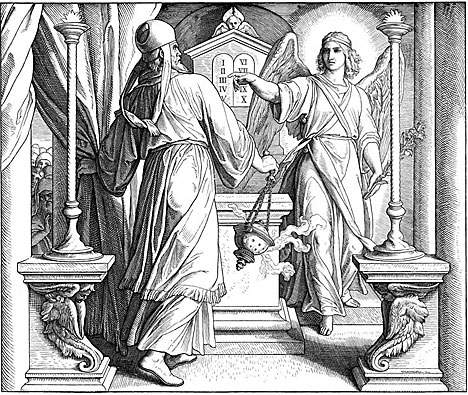
Here’s some interesting calculations concerning the day of Jesus’ birth in relation to Israel’s festal calendar. It was written by Michael Scheifler (a Seventh-day Adventist), and is reproduced here with his permission.
While much of the world celebrates the birth of Jesus Christ on the 25th of December, can the actual day of Jesus’ birth be determined from scripture? This question will be explored in some detail, and will yield a result that is quite intriguing. The first passage we will consider begins with the father of John the Baptist, Zacharias:
Continue reading
Comments Off | tags: 70 Weeks, Bible Chronology, Booths, Christmas, Chronicles, Daniel, Feasts, Luke, Tabernacles, Temple | posted in Biblical Theology, Quotes, The Last Days
Mar
15
2012
Some gents have been posting their favourite Jim Jordan quotes. Some are interesting. Some are funny. This one is tragic.
Continue reading
Comments Off | tags: Bible Chronology, Compromise, James Jordan | posted in Creation, Quotes
Jul
19
2011
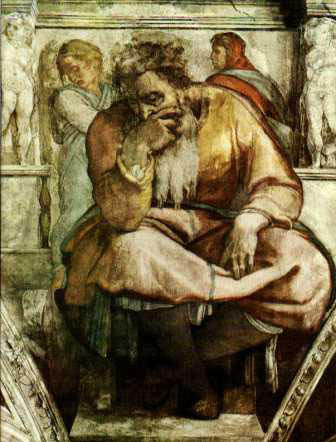
Biblical chronology isn’t always easy, but it provides the answers to many questions we have concerning Bible prophecy. James Jordan shows how crucial the book of Esther is for our understanding of Bible history:
The book of Esther is one of the most neglected of the books of the Bible. To be sure, sermons are preached on it, and commentaries have occasionally been written on it, but almost without exception Esther has been interpreted in isolation from the rest of Biblical history, chronology, and theology. Even many conservative commentators tend to view the events in Esther as minor occurrences that have been inflated in the narrative in order to make the point of the book. This is because they make the wrong assumptions about the dates of these events, and because they do not understand the importance of the events in Esther to the progress of revelation and redemption.
Continue reading
Comments Off | tags: Bible Chronology, Daniel, Esther, James Jordan, Jeremiah, Nebuchadnezzar, Zechariah | posted in Biblical Theology, Quotes, The Restoration Era
Nov
12
2009
 As the end of the ‘Creation week’ (slavery to Sabbath) that created a new nation, there were twelve judges. Twelve is the ‘offspring’ number, being the three of heaven married, multiplied with, the four of the Land.[1] However, we know these brave ‘champions’ were not a sabbath society but a rescue operation after the failure of the Levites.
As the end of the ‘Creation week’ (slavery to Sabbath) that created a new nation, there were twelve judges. Twelve is the ‘offspring’ number, being the three of heaven married, multiplied with, the four of the Land.[1] However, we know these brave ‘champions’ were not a sabbath society but a rescue operation after the failure of the Levites.
Continue reading
Comments Off | tags: Bible Chronology, Bible history, Bible Matrix, Boaz, Judges, Obed, Ruth, Samson, Samuel | posted in Biblical Theology
Jul
23
2009

Imagine finding a dinosaur alive in your backyard.
Dave Noble found some in the Blue Mountains near Sydney in 1994. This species didn’t die out 200 million years ago after all. A small colony survived. Now you can buy one for your garden. This dinosaur is the Wollemi Pine, the tree that time forgot.
Continue reading
Comments Off | tags: Bible Chronology, Evolution, Fossils | posted in Creation
Apr
10
2009
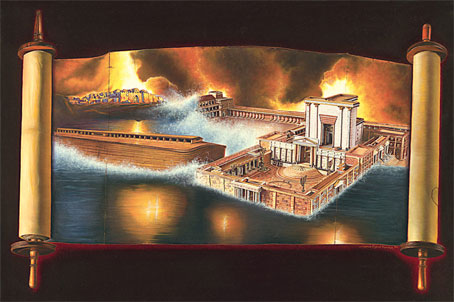
A couple of guys have written a book called Beyond Creation Science. As preterists, they understand there was a symbolic ‘flood’ across the Land of Israel under both Nebuchadnezzar’s Babylon and Nero/Vespasian’s Rome. Problem is, they read this back into Noah’s flood and try to say that this was only a local flood, which then allows them to compromise with old-earth Creationism.
It was ‘long-age’ geological assumptions that provided a ‘foundation’ for Darwin’s long-age biological fantasy. I would recommend Tas Walker’s site, Biblical Geology, for someone who really knows his stuff.
The position of these fellows causes more problems than it fixes. It makes the Bible’s very detailed chronology a joke, and forces a gap of millions of years into Genesis 1.
Here’s the solution:
Adam’s failure brought physical de-Creation. Cain founded a corrupt civilisation whose evil influence triumphed and was destroyed in a literal flood. Just like Cain, Ham was cursed, and his son Canaan’s influence led to social de-Creation. As God raised new land out of the waters after the flood, God would now perform another Creation miracle. In calling Abram, God was socially dividing the waters of the nations into the Land and the Sea. The era of the patriarchs, ruling fathers, began. God called Abram, and tore the world in two.
The land and sea division was a literal, physical land and sea in early Genesis. The ark of Noah was a literal ’world-in-a-box’, a safehouse and doorway to a new world. But when God called Abram, the ‘Land and Sea’ division was purely social, and the Tabernacle and Temple were a symbolic ‘world-in-a-box.’ These guys have confused these two and unwittingly undermined the authority of Scripture.
[Also, on hyperpreterist ‘Covenant Creationism’, see A Chronic Hysteresis.]
Comments Off | tags: Abraham, Against Hyperpreterism, Bible Chronology, Covenant Creationism, Temple, The flood | posted in Against Hyperpreterism, Biblical Theology, Creation, The Last Days
Apr
10
2009
In recaptulating Israel’s history, the seven letters in Revelation 2-3 confirm that the true Israel was transformed by the death and resurrection of Christ, progressing from Firstfruits through Pentecost to Trumpets. James Jordan writes:
“[Bible chronology] is a history of how the Divine Parent educated the core and centre of the human race, and then of how He called all nations to be grafted into that Olive Tree history so as to receive the benefit of it… The human race had matured to the point where it was fitting for Messiah to come, and come not only to save the race, but to bring the race to maturity… And then we can notice that the seven churches in Revelation 2-3 are each associated with a particular time in Old Covenant history. We can begin to apply the societal wisdom we have begun to learn from Israel’s history to address the particular problems and issues in our own churches. Is your church most like Pergamum? Well, that’s the wilderness church. Perhaps your church is made up of people who need to be addressed in a Law-oriented fashion. If your church is like Thyatira, maybe a strong dose of Psalms. If like Sardis, you need Jeremiah. And so forth.”
http://www.biblicalhorizons.com/biblical-horizons/no-195-how-to-do-reformed-theology-nowadays-part-4/
Comments Off | tags: Bible Chronology, Bible history, Feasts, James Jordan, Psalms, Revelation | posted in Biblical Theology, Totus Christus
Apr
10
2009
No Bible commentary is the last word, but James Jordan’s seven-year effort gets the ball through the hoop on Daniel. Here’s an excerpt from David Field’s review:
The approach of the book is marked by
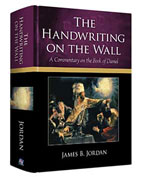 1. Immersion in and informed reference to the rest of the Hebrew Scriptures. The use of Genesis, Exodus, Leviticus, Ezra-Nehemiah, Esther, Isaiah, Jeremiah, Ezekiel, and Zechariah is astonishing and enriching at every turn. Use of or comment upon other books along the way are unfailingly stimulating and this applies to NT books as well, not least to Revelation which is greatly illumined by this work on Daniel.
1. Immersion in and informed reference to the rest of the Hebrew Scriptures. The use of Genesis, Exodus, Leviticus, Ezra-Nehemiah, Esther, Isaiah, Jeremiah, Ezekiel, and Zechariah is astonishing and enriching at every turn. Use of or comment upon other books along the way are unfailingly stimulating and this applies to NT books as well, not least to Revelation which is greatly illumined by this work on Daniel.
2. Confident deployment of redemptive-historical paradigms which have themselves been recognized through close and repeated study of the whole Bible. In particular, theologico-spatial zones, old creation /new creation eras, and prophet /priest /king roles feature heavily and often have real power to unlock or clarify the subject in hand.
3. The closest of close structural analysis of the sort that comes from multiple readings. Chiasms and parallels and other patterning devices are attended to with great care and in such a way as positively informs the interpretation rather than being mere observations along the path.
4. Seriousness about chronology. This is one of the characteristics of Jordan’s work overall, since he sees emphasis on “ideas” at the expense of history as revealing and strengthening the gnosticism of much contemporary Christianity. The detailed chronological work lying behind his interpretation of Jeremiah and Ezekiel and his resolution of some of the Daniel “difficulties” is awesome.
5. Interpretative weight given to what still gets called “inter-testamental” history. Inter-testamental history is redemptive history and Jordan emphasizes that God speaks to and about that period in the patterns of Daniel 1-6 and in the prophecies of Daniel 1-7.
6. Attention to numerics: word-counts, significant numbers, and the meaning of numbers. There is work here to compare with Bauckham’s work on Revelation.
7. Typology. This is not a “typological” commentary as such because although half of Daniel is narrative, half of it is apocalyptic prophecy. But when you attend to redemptive-historical patterns and to literary structures and sequences and to the importance of history as Jordan does, then, in some sense, all your work will be typological. At the macro-historical this means that Daniel is one of God’s major interpretative words for the entire second phase of the first creation. The first creation has a former days and a latter days and then gives way to the new creation. Daniel tells us about the last centuries and decades of the latter days of the old world.
8. Cheerful (and sometimes curmudgeonly) unfashionableness. Early dating, traditional authorship, defense of biblical chronology, unashamed constant reference to Christ (how could it be otherwise?!), impatience with “unbelieving scholarship”, utter lack of interest in being respected and consistent resolve to be useful. This may be a difficult example for young scholars (like those in Daniel 1!) to follow but it is thoroughly refreshing.
9. Theological creativity at level “Genius”. I thought I knew Jordan’s work reasonably well but over and over and over again there are “aha!” moments. In my copy now there are almost more sentences and paragraphs marked than unmarked!”
“The Handwriting on the Wall” is available from www.americanvision.com
Also available as an e-book.
Comments Off | tags: Apocalyptic, Bible Chronology, Bible history, Book Review, Daniel, David Field, James Jordan, Typology | posted in Biblical Theology
Apr
8
2009
When were the gospels written?
Matthew is the first of the gospels; there can be little doubt of this. The notion that Mark was first because Mark is shorter is nonsensical. Matthew was one of the disciples and was a man of letters. Who better to take notes during Jesus’ lifetime?
Moreover, immediately after Pentecost there would have been a demand for a book containing the teaching and works of Jesus.
The Jews were a people of the book. Each time God did a great work, a new part of Scripture was written to tell about it. The 3000 converts on the day of Pentecost would have expected such a book, and we can be pretty sure that Matthew set right down to write it. Doubtless he spoke with the other disciples, and perhaps Matthew’s gospel is to some extent a joint work. It is perfectly reasonable to assume that within a month after Pentecost copies of Matthew’s gospel were in circulation.
from BIBLICAL Horizons, No. 94 and 95.
Toward a Chiastic Understanding of the Gospel According to Matthew, Parts 1 & 2
© 1997 Biblical Horizons | www.biblicalhorizons.com
2 comments | tags: Bible Chronology, Bible history, Gospels, James Jordan | posted in Biblical Theology
Apr
8
2009
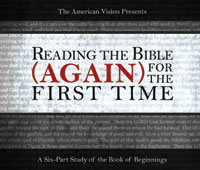 Higher criticism’s rejection of the Bible’s chronology (followed by much of evangelicalism) robs Christians of some amazing facts. According to James Jordan, Joseph was sold by his brothers before the birth of Benjamin, and Isaac (the sacrifice) died a year before Joseph’s release from prison.
Higher criticism’s rejection of the Bible’s chronology (followed by much of evangelicalism) robs Christians of some amazing facts. According to James Jordan, Joseph was sold by his brothers before the birth of Benjamin, and Isaac (the sacrifice) died a year before Joseph’s release from prison.
James B. Jordan, Reading the Bible (again) for the First Time (Audio series).
Comments Off | tags: Bible Chronology, James Jordan | posted in Biblical Theology
































